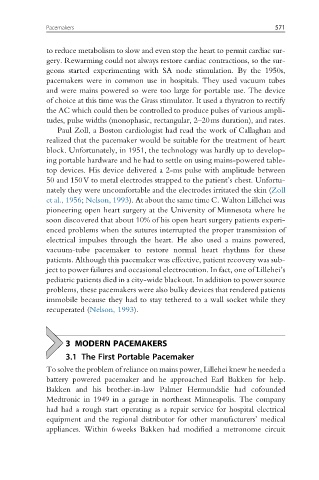Page 578 - Handbook of Biomechatronics
P. 578
Pacemakers 571
to reduce metabolism to slow and even stop the heart to permit cardiac sur-
gery. Rewarming could not always restore cardiac contractions, so the sur-
geons started experimenting with SA node stimulation. By the 1950s,
pacemakers were in common use in hospitals. They used vacuum tubes
and were mains powered so were too large for portable use. The device
of choice at this time was the Grass stimulator. It used a thyratron to rectify
the AC which could then be controlled to produce pulses of various ampli-
tudes, pulse widths (monophasic, rectangular, 2–20ms duration), and rates.
Paul Zoll, a Boston cardiologist had read the work of Callaghan and
realized that thepacemaker wouldbesuitablefor thetreatment of heart
block. Unfortunately, in 1951, the technology was hardly up to develop-
ing portable hardware and he had to settle on using mains-powered table-
top devices. His device delivered a 2-ms pulse with amplitude between
50 and 150V to metal electrodes strapped to the patient’s chest. Unfortu-
nately they were uncomfortable and the electrodes irritated the skin (Zoll
et al., 1956; Nelson, 1993). At about the same time C. Walton Lillehei was
pioneering open heart surgery at the University of Minnesota where he
soon discovered that about 10% of his open heart surgery patients experi-
enced problems when the sutures interrupted the proper transmission of
electrical impulses through the heart. He also used a mains powered,
vacuum-tube pacemaker to restore normal heart rhythms for these
patients. Although this pacemaker was effective, patient recovery was sub-
ject to power failures and occasional electrocution. In fact, one of Lillehei’s
pediatric patients died in a city-wide blackout. In addition to power source
problems, these pacemakers were also bulky devices that rendered patients
immobile because they had to stay tethered to a wall socket while they
recuperated (Nelson, 1993).
3 MODERN PACEMAKERS
3.1 The First Portable Pacemaker
To solve the problem of reliance on mains power, Lillehei knew he needed a
battery powered pacemaker and he approached Earl Bakken for help.
Bakken and his brother-in-law Palmer Hermundslie had cofounded
Medtronic in 1949 in a garage in northeast Minneapolis. The company
had had a rough start operating as a repair service for hospital electrical
equipment and the regional distributor for other manufacturers’ medical
appliances. Within 6weeks Bakken had modified a metronome circuit

